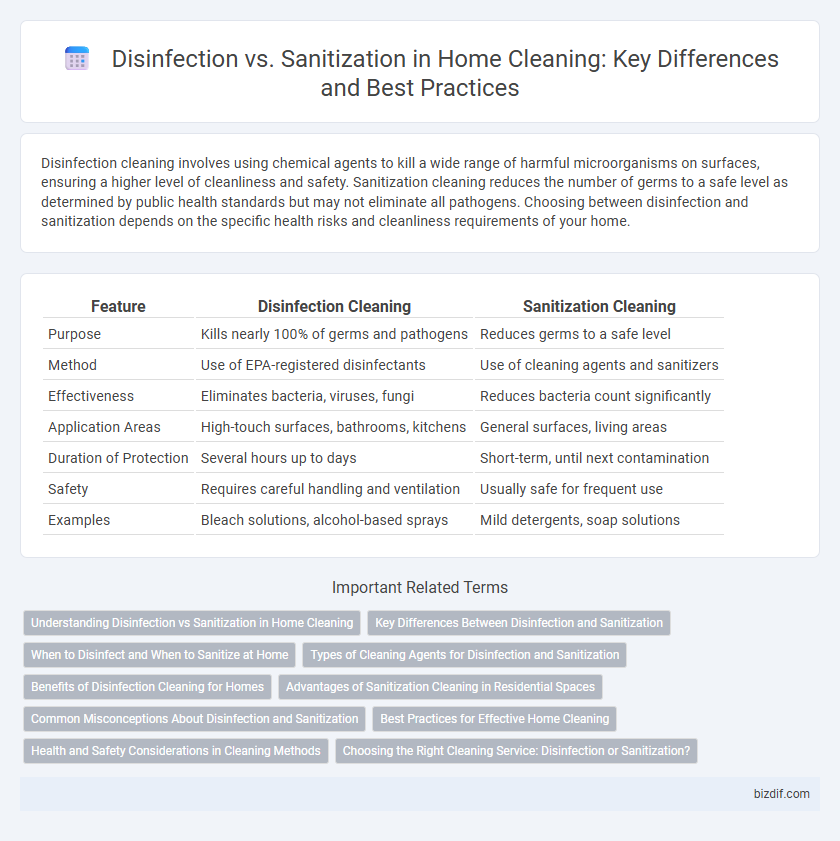Disinfection cleaning involves using chemical agents to kill a wide range of harmful microorganisms on surfaces, ensuring a higher level of cleanliness and safety. Sanitization cleaning reduces the number of germs to a safe level as determined by public health standards but may not eliminate all pathogens. Choosing between disinfection and sanitization depends on the specific health risks and cleanliness requirements of your home.
Table of Comparison
| Feature | Disinfection Cleaning | Sanitization Cleaning |
|---|---|---|
| Purpose | Kills nearly 100% of germs and pathogens | Reduces germs to a safe level |
| Method | Use of EPA-registered disinfectants | Use of cleaning agents and sanitizers |
| Effectiveness | Eliminates bacteria, viruses, fungi | Reduces bacteria count significantly |
| Application Areas | High-touch surfaces, bathrooms, kitchens | General surfaces, living areas |
| Duration of Protection | Several hours up to days | Short-term, until next contamination |
| Safety | Requires careful handling and ventilation | Usually safe for frequent use |
| Examples | Bleach solutions, alcohol-based sprays | Mild detergents, soap solutions |
Understanding Disinfection vs Sanitization in Home Cleaning
Disinfection cleaning involves using chemical agents to kill or eliminate nearly all pathogenic microorganisms on surfaces, making it essential for preventing disease transmission in high-touch areas. Sanitization cleaning reduces the number of germs to a safe level as determined by public health standards, primarily focusing on lowering microbial load rather than complete elimination. Understanding the difference ensures homeowners choose the appropriate method to maintain a safe and healthy living environment.
Key Differences Between Disinfection and Sanitization
Disinfection cleaning targets eliminating nearly 100% of harmful pathogens, including bacteria, viruses, and fungi, using strong chemical agents, making it essential for high-risk areas like hospitals. Sanitization cleaning reduces the number of germs to a safe level as judged by public health standards, primarily focusing on lowering bacteria counts on surfaces like kitchen counters. The key differences lie in their efficacy, with disinfection aiming for complete pathogen destruction and sanitization focusing on lowering microbial presence to safe limits.
When to Disinfect and When to Sanitize at Home
Disinfection cleaning eliminates nearly all pathogens on surfaces and is essential after illness exposure or in high-touch areas during flu season. Sanitization cleaning reduces bacteria to safe levels and is suitable for routine maintenance on household items like countertops and dining tables. Prioritize disinfection for bathrooms and kitchens after contamination, while regular sanitization keeps general living spaces hygienic without harsh chemicals.
Types of Cleaning Agents for Disinfection and Sanitization
Disinfection cleaning utilizes chemical agents such as bleach, hydrogen peroxide, and quaternary ammonium compounds to eliminate a broad spectrum of pathogens including bacteria, viruses, and fungi. Sanitization cleaning employs milder agents like soaps, detergents, and alcohol-based solutions aimed at reducing microbial load to safe health standards rather than complete eradication. The selection of cleaning agents depends on the required level of microbial control, surface compatibility, and specific health guidelines.
Benefits of Disinfection Cleaning for Homes
Disinfection cleaning eliminates up to 99.9% of harmful pathogens and bacteria, significantly reducing the risk of infections in homes. This method uses EPA-registered disinfectants that target viruses like influenza, norovirus, and COVID-19, providing a deeper level of sanitation compared to standard sanitization cleaning. Homeowners benefit from improved indoor air quality and a safer environment, especially for children, elderly individuals, and those with compromised immune systems.
Advantages of Sanitization Cleaning in Residential Spaces
Sanitization cleaning in residential spaces effectively reduces the number of harmful microorganisms on surfaces to a safer level, promoting a healthier living environment without the use of harsh chemicals. It helps maintain cleanliness while preserving the integrity of household materials such as wood, fabric, and painted surfaces, unlike some disinfection methods that may cause damage or discoloration. The process also supports ongoing prevention of illness by minimizing allergens and bacteria, making it an ideal choice for homes with children, pets, or individuals with sensitivities.
Common Misconceptions About Disinfection and Sanitization
Disinfection cleaning and sanitization cleaning are often confused, but disinfection eliminates nearly all pathogens while sanitization reduces bacteria to a safe level. A common misconception is that sanitization is sufficient to prevent illness, yet disinfection is necessary for high-risk areas requiring thorough germ eradication. Understanding the distinct purposes of both processes ensures effective home cleaning and health protection.
Best Practices for Effective Home Cleaning
Disinfection cleaning involves the use of EPA-approved disinfectants to kill a high percentage of pathogens on surfaces, significantly reducing risks of infections in the home. Sanitization cleaning lowers the number of germs to a safe level as defined by public health standards, often using detergents combined with mild disinfectants. For effective home cleaning, prioritize disinfecting high-touch areas such as doorknobs, countertops, and light switches with appropriate products while maintaining regular sanitization routines to sustain a healthier living environment.
Health and Safety Considerations in Cleaning Methods
Disinfection cleaning eliminates nearly 99.9% of pathogens by using EPA-registered disinfectants, making it essential for high-touch surfaces in healthcare and food preparation areas to prevent disease transmission. Sanitization cleaning reduces the number of germs to a safe level as judged by public health standards, suitable for routine maintenance in residential settings to minimize allergen buildup. Prioritizing disinfection in environments with vulnerable populations enhances health safety, while sanitization supports general cleanliness and reduces microbial risks efficiently.
Choosing the Right Cleaning Service: Disinfection or Sanitization?
Disinfection cleaning eliminates nearly 99.9% of pathogens, making it essential for high-risk areas such as hospitals or homes with sick individuals, while sanitization cleaning reduces bacteria levels to a safe threshold for general maintenance. Choosing between disinfection and sanitization depends on the specific health requirements, surface types, and frequency of cleaning needed in your home. Professional cleaning services tailor their methods to effectively address germs, viruses, and allergens, ensuring optimal hygiene based on your environment's vulnerability.
Disinfection Cleaning vs Sanitization Cleaning Infographic

 bizdif.com
bizdif.com